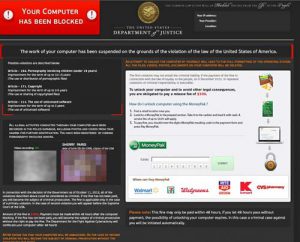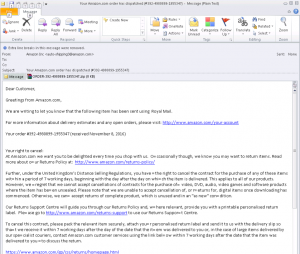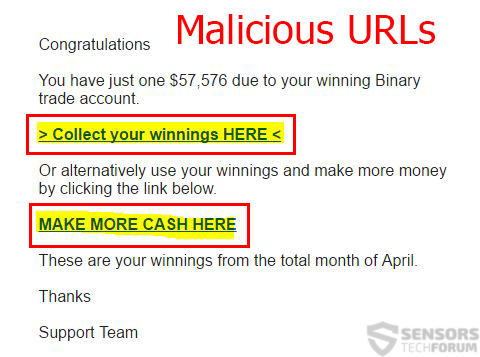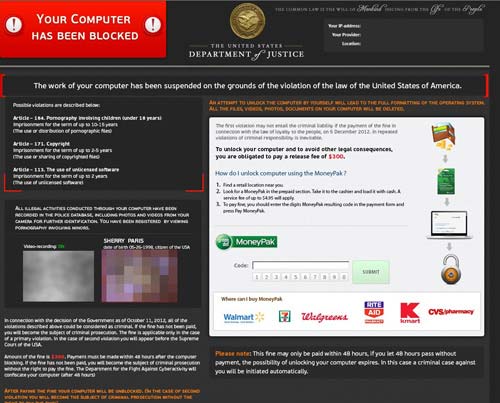 Article created to help you remove the Arestocrat lockscreen Department of Justice ransomware infection and unlock your infected computer.
Article created to help you remove the Arestocrat lockscreen Department of Justice ransomware infection and unlock your infected computer.
A ransomware virus, detected as Ransom.Arestocrat detected first In 2013 has still proven to be active and lock the screens on the computers infected by it. The infection downloads malicious files and modifies settings on the infected computer so that it is possible to cause the screen to freeze. The Arestocrat virus then displays a false message that It is the Department of Justice and accuses the user of illegal activity. However, fact is that all departments of the government do not operate this way and if you have seen the locked screen from Arestocrat, we strongly suggest to read the following material thoroughly.

Threat Summary
| Name | |
| Type | Ransomware (Lockscreen) |
| Short Description | Locks the computer, displaying a fake government message from DOJ. |
| Symptoms | A message from the Department of Justice is displayed with ransom demands. |
| Distribution Method | Spam Emails, Email Attachments, File Sharing Networks. |
| Detection Tool |
See If Your System Has Been Affected by malware
Download
Malware Removal Tool
|
| User Experience | Join our forum to Discuss Flimrans Ransomware. |

Arestocrat Virus – How Does It Infect
To spread online, the hackers behind this lockscreen type of virus may take advantage of multiple different tools and kits. The most often used of those are:
- Exploit kits.
- File joiners that combine malicious code with legitimate executables.
- Spamming bots or services.
- A pre-created list of fake e-mail addresses with good quality.
- A list with e-mail addresses to spam.
- Hacked online accounts.
- Shady domains and servers for command and control.
The usage of these tools may result in the spamming of malicious files as well as web links that contain the Arestocrat infection. These may be accompanied by an e-mail message with a very convincing statement, whose only aim is to get the user to either click on the malicious web link or open the attachment. Example images of such spam e-mails can be seen below:
Besides using new methods to infect users, the cyber-criminals also use new deceitful tricks, such as use the name of the user of the e-mail account in the e-mail’s text, for further trust and convincing.
In addition to spammed e-mails, the above-mentioned tools may also be used to spread the Arestocrat virus in multiple other ways, such as:
- Via fake updates of Adobe or Windows posted on shady sites or downloaded via unwanted software.
- Through fake program licensing patches or key generators uploaded from hacked online accounts on torrent websites.
- Via game cracks, patches or Self-Extracting archives. (SFX)

Arestocrat Virus – Further Information
As soon as the user opens the infection file or web link, a malicious code may be executed. This code connects to a distribution host and via an unsecured web port downloads the payload of Arestocrat lockscreen. After the payload has been downloaded on the infected computer, it may be situated on the following locations:
- %AppData%
- %Local%
- %LocalLow%
- %Roaming%
As soon as this malware has been situated, it may begin to heavily modify the Windows Registry Editor. The following Windows Registry sub-keys may be targeted for modification:
→ HKCU\Software\Microsoft\Windows\CurrentVersion\Explorer\Shell Folders\Local AppData
HKCU\Software\Microsoft\Windows\CurrentVersion\Explorer\Shell Folders\Templates
HKCU\Software\Microsoft\Windows\CurrentVersion\Explorer\Shell Folders\AppData
HKCU\Software\Microsoft\Windows\CurrentVersion\Explorer\Shell Folders\Cache
HKCU\Software\Microsoft\Windows\CurrentVersion\Explorer\Shell Folders\Cookies
HKCU\Software\Microsoft\Windows\CurrentVersion\Explorer\Shell Folders\History
HKCU\Software\Microsoft\Windows\CurrentVersion\Explorer\Shell Folders\AppData
HKLM\Software\Microsoft\Windows\CurrentVersion\Explorer\Shell Folders\CommonAppData
HKLM\System\CurrentcontrolSet\Hardware Profiles\0001\Software\Microst\windows\CurrentVersion\Internet Settings\ProxyEnable
HKCU\Software\Microsoft\Windows\CurrentVersion\Internet Settings\Connections\SavedLegacySettings
HKCU\Software\Microsoft\Windows\Run\qcgce2mrvjq91kk1e7pnbb19m52fx
HKCU\Software\Microsoft\Command Processor\AutoRun
HKCU\Software\Microsoft\Windows NT\CurrentVersion\Winlogon\Shell
HKCR\CLSID\{random alpha numerical key}\InProcServer32\ThreadingModel
HKCR\CLSID\{random alpha numerical key}\InProcServer32\TheadingModel\(Default)
HKCU\Software\Microsoft\Windows\CurrentVersion\Internet Settings\ZoneMap\UNCAsIntranet
HKCU\Software\Microsoft\Windows\CurrentVersion\Internet Settings\ZoneMap\AutoDetect
After this modification has been performed the lockscreen virus may cause a force reset on the computer of the user after which the Arestocrat Lockscreen may appear:
From there, the user may be demanded to pay a “fee” to get access back to his computer. Such type of police ransomware viruses are nothing new and fortunately they do not encrypt files, meaning they can be removed.

Remove Arestocrat Lockscreen Ransom Completely
For the removal process of this ransomware, we strongly suggest you to follow the removal instructions below. They are carefully designed to help you bypass the lockscreen by booting your computer into safe mode, after which perform the removal either manually or automatically. For maximum effectiveness, we recommend to remove malicious objects automatically by following the removal instructions below and downloading an advanced anti-malware program. Such will remove the files from your computer and revert all the settings back to normal by removing the malicious objects controlling them and in the meantime protect your computer against future ransomware infections.
- Step 1
- Step 2
- Step 3
- Step 4
- Step 5
Step 1: Scan for with SpyHunter Anti-Malware Tool



Ransomware Automatic Removal - Video Guide
Step 2: Uninstall and related malware from Windows
Here is a method in few easy steps that should be able to uninstall most programs. No matter if you are using Windows 10, 8, 7, Vista or XP, those steps will get the job done. Dragging the program or its folder to the recycle bin can be a very bad decision. If you do that, bits and pieces of the program are left behind, and that can lead to unstable work of your PC, errors with the file type associations and other unpleasant activities. The proper way to get a program off your computer is to Uninstall it. To do that:


 Follow the instructions above and you will successfully delete most unwanted and malicious programs.
Follow the instructions above and you will successfully delete most unwanted and malicious programs.
Step 3: Clean any registries, created by on your computer.
The usually targeted registries of Windows machines are the following:
- HKEY_LOCAL_MACHINE\Software\Microsoft\Windows\CurrentVersion\Run
- HKEY_CURRENT_USER\Software\Microsoft\Windows\CurrentVersion\Run
- HKEY_LOCAL_MACHINE\Software\Microsoft\Windows\CurrentVersion\RunOnce
- HKEY_CURRENT_USER\Software\Microsoft\Windows\CurrentVersion\RunOnce
You can access them by opening the Windows registry editor and deleting any values, created by there. This can happen by following the steps underneath:


 Tip: To find a virus-created value, you can right-click on it and click "Modify" to see which file it is set to run. If this is the virus file location, remove the value.
Tip: To find a virus-created value, you can right-click on it and click "Modify" to see which file it is set to run. If this is the virus file location, remove the value.
Before starting "Step 4", please boot back into Normal mode, in case you are currently in Safe Mode.
This will enable you to install and use SpyHunter 5 successfully.
Step 4: Boot Your PC In Safe Mode to isolate and remove





Step 5: Try to Restore Files Encrypted by .
Method 1: Use STOP Decrypter by Emsisoft.
Not all variants of this ransomware can be decrypted for free, but we have added the decryptor used by researchers that is often updated with the variants which become eventually decrypted. You can try and decrypt your files using the instructions below, but if they do not work, then unfortunately your variant of the ransomware virus is not decryptable.
Follow the instructions below to use the Emsisoft decrypter and decrypt your files for free. You can download the Emsisoft decryption tool linked here and then follow the steps provided below:
1 Right-click on the decrypter and click on Run as Administrator as shown below:

2. Agree with the license terms:

3. Click on "Add Folder" and then add the folders where you want files decrypted as shown underneath:

4. Click on "Decrypt" and wait for your files to be decoded.

Note: Credit for the decryptor goes to Emsisoft researchers who have made the breakthrough with this virus.
Method 2: Use data recovery software
Ransomware infections and aim to encrypt your files using an encryption algorithm which may be very difficult to decrypt. This is why we have suggested a data recovery method that may help you go around direct decryption and try to restore your files. Bear in mind that this method may not be 100% effective but may also help you a little or a lot in different situations.
Simply click on the link and on the website menus on the top, choose Data Recovery - Data Recovery Wizard for Windows or Mac (depending on your OS), and then download and run the tool.
-FAQ
What is Ransomware?
is a ransomware infection - the malicious software that enters your computer silently and blocks either access to the computer itself or encrypt your files.
Many ransomware viruses use sophisticated encryption algorithms to make your files inaccessible. The goal of ransomware infections is to demand that you pay a ransom payment to get access to your files back.
What Does Ransomware Do?
Ransomware in general is a malicious software that is designed to block access to your computer or files until a ransom is paid.
Ransomware viruses can also damage your system, corrupt data and delete files, resulting in the permanent loss of important files.
How Does Infect?
Via several ways. Ransomware infects computers by being sent via phishing emails, containing virus attachment. This attachment is usually masked as an important document, like an invoice, bank document or even a plane ticket and it looks very convincing to users.
Another way you may become a victim of is if you download a fake installer, crack or patch from a low reputation website or if you click on a virus link. Many users report getting a ransomware infection by downloading torrents.
How to Open . files?
You can't without a decryptor. At this point, the . files are encrypted. You can only open them once they are decrypted using a specific decryption key for the particular algorithm.
What to Do If a Decryptor Does Not Work?
Do not panic, and backup the files. If a decryptor did not decrypt your . files successfully, then do not despair, because this virus is still new.
Can I Restore "." Files?
Yes, sometimes files can be restored. We have suggested several file recovery methods that could work if you want to restore . files.
These methods are in no way 100% guaranteed that you will be able to get your files back. But if you have a backup, your chances of success are much greater.
How To Get Rid of Virus?
The safest way and the most efficient one for the removal of this ransomware infection is the use a professional anti-malware program.
It will scan for and locate ransomware and then remove it without causing any additional harm to your important . files.
Can I Report Ransomware to Authorities?
In case your computer got infected with a ransomware infection, you can report it to the local Police departments. It can help authorities worldwide track and determine the perpetrators behind the virus that has infected your computer.
Below, we have prepared a list with government websites, where you can file a report in case you are a victim of a cybercrime:
Cyber-security authorities, responsible for handling ransomware attack reports in different regions all over the world:
Germany - Offizielles Portal der deutschen Polizei
United States - IC3 Internet Crime Complaint Centre
United Kingdom - Action Fraud Police
France - Ministère de l'Intérieur
Italy - Polizia Di Stato
Spain - Policía Nacional
Netherlands - Politie
Poland - Policja
Portugal - Polícia Judiciária
Greece - Cyber Crime Unit (Hellenic Police)
India - Mumbai Police - CyberCrime Investigation Cell
Australia - Australian High Tech Crime Center
Reports may be responded to in different timeframes, depending on your local authorities.
Can You Stop Ransomware from Encrypting Your Files?
Yes, you can prevent ransomware. The best way to do this is to ensure your computer system is updated with the latest security patches, use a reputable anti-malware program and firewall, backup your important files frequently, and avoid clicking on malicious links or downloading unknown files.
Can Ransomware Steal Your Data?
Yes, in most cases ransomware will steal your information. It is a form of malware that steals data from a user's computer, encrypts it, and then demands a ransom in order to decrypt it.
In many cases, the malware authors or attackers will threaten to delete the data or publish it online unless the ransom is paid.
Can Ransomware Infect WiFi?
Yes, ransomware can infect WiFi networks, as malicious actors can use it to gain control of the network, steal confidential data, and lock out users. If a ransomware attack is successful, it could lead to a loss of service and/or data, and in some cases, financial losses.
Should I Pay Ransomware?
No, you should not pay ransomware extortionists. Paying them only encourages criminals and does not guarantee that the files or data will be restored. The better approach is to have a secure backup of important data and be vigilant about security in the first place.
What Happens If I Don't Pay Ransom?
If you don't pay the ransom, the hackers may still have access to your computer, data, or files and may continue to threaten to expose or delete them, or even use them to commit cybercrimes. In some cases, they may even continue to demand additional ransom payments.
Can a Ransomware Attack Be Detected?
Yes, ransomware can be detected. Anti-malware software and other advanced security tools can detect ransomware and alert the user when it is present on a machine.
It is important to stay up-to-date on the latest security measures and to keep security software updated to ensure ransomware can be detected and prevented.
Do Ransomware Criminals Get Caught?
Yes, ransomware criminals do get caught. Law enforcement agencies, such as the FBI, Interpol and others have been successful in tracking down and prosecuting ransomware criminals in the US and other countries. As ransomware threats continue to increase, so does the enforcement activity.
About the Research
The content we publish on SensorsTechForum.com, this how-to removal guide included, is the outcome of extensive research, hard work and our team’s devotion to help you remove the specific malware and restore your encrypted files.
How did we conduct the research on this ransomware?
Our research is based on an independent investigation. We are in contact with independent security researchers, and as such, we receive daily updates on the latest malware and ransomware definitions.
Furthermore, the research behind the ransomware threat is backed with VirusTotal and the NoMoreRansom project.
To better understand the ransomware threat, please refer to the following articles which provide knowledgeable details.
As a site that has been dedicated to providing free removal instructions for ransomware and malware since 2014, SensorsTechForum’s recommendation is to only pay attention to trustworthy sources.
How to recognize trustworthy sources:
- Always check "About Us" web page.
- Profile of the content creator.
- Make sure that real people are behind the site and not fake names and profiles.
- Verify Facebook, LinkedIn and Twitter personal profiles.





